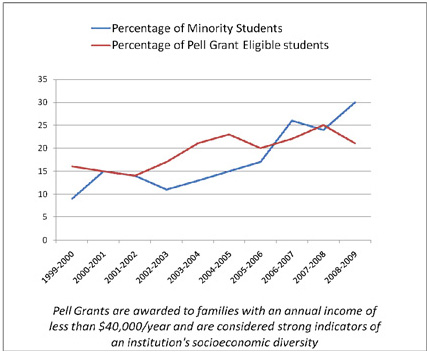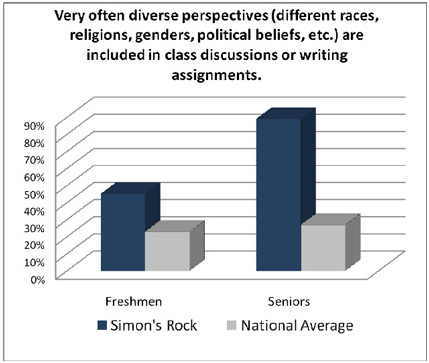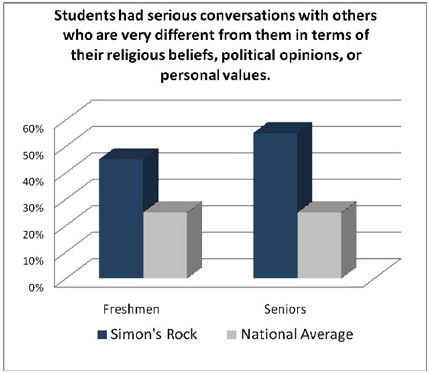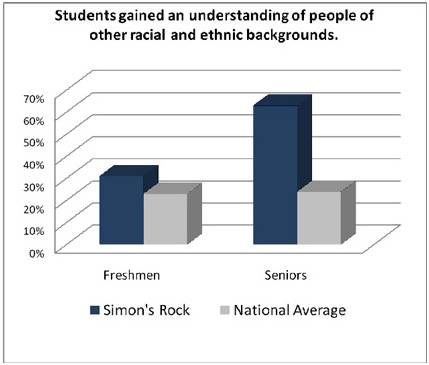Bucking the College Diversity Cult
Noah Steadman, American Renaissance, December 28, 2012
Bard College at Simon’s Rock is a liberal-arts school in Great Barrington, in the Massachusetts Berkshires. The town was established in colonial times, and is nearly 95 percent white. The college was founded in 1964, and is very small; there are fewer than 400 students, and almost all live on campus.
Since Bard acquired Simon’s Rock Early College in 1979, it has pushed “diversity” very hard. This graph, taken from the college website, is a source of pride: Non-whites have grown from 10 percent to 30 percent of the student body in the last 10 years.
This graph, also taken from the website, brags about how Simon’s Rock forces diversity into the curriculum.
The result is that, compared to students who attend lesser institutions, Simon’s Rock students claim to be greatly enriched.
The website describes efforts to make Simon’s Rock more diverse.
When Mary Marcy, provost and vice president of Bard College at Simon’s Rock, arrived on campus in 2004 she recognized an opportunity to deepen the College’s commitment to diversity. Like many initiatives at Simon’s Rock, the object was to go beyond the numbers and to help forge meaningful connections between and among students and faculty from diverse backgrounds with integrity, significance and context.
All students must take a course in “cultural perspectives,” and the campus celebrates something called Diversity Day. It has a Director of Multi-Cultural affairs, “spaces for students of color to meet,” a Black Student Union, a student-run Race Task Force, a Queer Student Alliance, and a Latino Student Alliance — all for just a few hundred students.
Simon’s Rock has indeed “deepened its commitment to diversity” since 2004, to the point of absurdity. When I enrolled as a freshman last fall I was unaware just how zealous the school was. Everyone took it for granted that diversity was a wonderful thing, but no one ever explained why.
It was clear, however, that many students self-segregated, with Asians spending time with Asians, blacks with blacks, etc. Encouraging students to join racial groups such as the Black Student Union encouraged identity politics and ran counter to the professed goal of diversity. The hypocrisy of this never dawned on anyone until I decided to call it to their attention.
Diversity Day is an important observance at Simon’s Rock; all courses are cancelled and students must attend three seminars on diversity. We had our pick of about 20 sessions on race, gender, and class. They had names such as “Are We Born Racist?” “Am I A Racist?” and “Dear White People,” which explained white privilege. There was no intellectual diversity.
I prepared for Diversity Day by putting up two dozen fliers. They asked students to email me five benefits of diversity, aside from ethnic food and music. My plan was to compile a list of the benefits and conduct a workshop to discuss them on Diversity Day. I never said diversity was bad; I just wanted to hear the reasons why it is good.
The fliers were all torn down and some students cut them into snowflakes or paper dolls holding hands. I learned that my flier was going to be discussed at a Black Student Union meeting in a few days, so I decided to go.
There were about 30 people in the room, in what was essentially a kangaroo court. Everyone sat in a circle and went around the room complaining that I was “invalidating the existence” of minorities and was willfully ignorant of my white privilege. They talked about how personally offended they were and how disgusting it was for me to ask for an explanation of the advantages of diversity. This went on for nearly two hours. I had only a minute or two to respond. At one point, a black student began to agree with me, but other blacks told him to shut up, saying I “would’ve supported slavery.”
I did not hear a single argument in favor of diversity, but there were implied threats of physical violence if I acted up again.
I received a lot of e-mail about the flier, mostly insults. A few people actually sent me arguments in favor of diversity: It broadens your perspective and makes you worldlier. When I put the text into a Google search, I found it had been copied from a website.
There were also Facebook comments that show how Simon’s Rock students think. One girl called me a “white freshman idiot” and complained that “the faculty and staff don’t do a good enough job of really reinforcing [anti-racism] to the white students in its population.” One student wanted to know, “Do we have a flag pole we can duct tape him to? Preferably naked.” An Asian Indian student wrote, “Go punch him in the gut, then talk to him.” Another student wrote “I just consider this fucker fresh meat.” One offered a reward “to whoever gives this kid the best swift kick in the ass.” Another student’s plan was to “drop him off in some housing projects somewhere, I’d say kick his ass, but daamn, why give him another reason to play the sniveling victim. For God’s sake, he sounds like the reincarnation of Samuel George Morton.” Another Indian wrote, “Your very presence effectively oppresses the being of people of color. There’s a thing called history.”
It is remarkable how quickly their fantasies turn to violence when anyone challenges their dogmas. Some people even started using my name to post outrageous messages on discussion boards. One included an image of the Simon’s Rock campus with cross hairs on it, and another asked, “Can someone tell me how to make a bomb?” I was called down to the Great Barrington police station, but the officers quickly accepted my explanation that these messages were posted by impostors.
An upperclassman, a Dravidian Indian, sent me a detailed response in which he accused me of having a “white supremacist ideology” and telling me to “check my privilege.” He went on a tirade against white Christian men, claimed he was a member of an oppressed group, and that I was the oppressor. He also called me a white boy.
I replied to his arguments and made sure to call him an Indian boy — but that was when I got in trouble with the administration. He said that I had “crossed the line between free speech and hate speech,” and filed a formal complaint. He claimed I had harassed him so terribly and his feelings were so badly hurt that he didn’t feel comfortable going about his day-to-day activities. This student was a critical theory major, but apparently couldn’t handle criticism.
I had to respond to the complaint. I argued that my accuser didn’t have a right not to be offended, and that if what I said to him was inflammatory and merited a harassment charge, then he should be charged as well, since he said exactly the same thing to me. The school nevertheless accused me of harassment and ordered a psychological assessment and diversity training — at my own expense. Even worse, there was an attempt to expel me. I was sent home for a de facto suspension of more than a week while the provost decided my fate.
Needless to say, my family was shocked by all this. They could hardly believe I was getting in so much trouble and being treated like a danger to the campus just because I asked for five benefits of diversity.
I got in touch with the Foundation for Individual Rights in Education (FIRE), and my parents threatened to sue the school if I were expelled. Perhaps for this reason, the provost gave up on the idea. I met with the president of the college, and he had to concede that I had done nothing wrong. I was finally allowed back on campus — to the dismay of many students.
As it happened, Diversity Day was held during the very week I came back — but it was a flop. The non-white students who were supposed to be running many of the workshops boycotted the event. I didn’t show up to watch, but they gathered on campus and handed out fliers. Their flier (see entire text here) says the problems all began with “a document distributed by a student on campus questioning the value of diversity, and therein questioning our very existence and invalidating our lived experiences.”
The flier went on to complain that “the provost has, in recent decisions, explicitly gone against our wishes and best interests as a marginalized and oppressed faction, essentially legitimizing white supremacist ideologies on this campus.” So far as I can tell, the failure to expel me was what legitimized white supremacy, but in any case, they had “feelings of being unsafe and threatened.” They said that if the administration were really serious about diversity, “each day would be observed as diversity day, and every day, the needs of the marginalized students in this community would be met and with dignity and respect.” A mere one-day Diversity Day was “a consolation prize” so they tried to shut it down.
A video of the boycott that was made for the school paper can be found here.
I have decided to transfer to another college, but I have not yet decided where I will go. Because I chose to leave Simon’s Rock I did not have to take the diversity training or undergo the psychological assessment — though that would certainly have been an interesting experience.



















